Article Written by Grace Vachon
What Makes a Plant Species Invasive?
Ivy winding up the trunk of a tree is a common and pleasant sight here on Cape Cod. However, what you may not know is that this ivy is most likely an invasive called English ivy. While some invasive plants like English ivy can be aesthetically pleasing, they are anything but good for the environment. You may have heard a lot about invasive species, but what makes a species invasive? Invasive species are plants or animals that are not native to an area but that also cause widespread harm to ecosystems and human livelihoods. Non-native plants that don’t cause ecological destruction are not considered invasive, so don’t confuse the term “invasive” with the terms “non-native” or “exotic.” They are not interchangeable. Similarly, native plants can display nuisance behavior just like invasives. One such example is greenbriar (also called cat briar), which is a common site on Cape Cod’s hiking trails. While native, greenbriar grows in dense thickets that take up large swaths of the forest understory, often entangling other plants. It is a thick green vine whose sharp thorns make it even more of a pain to deal with. As a result, it is often removed as part of land stewardship efforts despite being native.
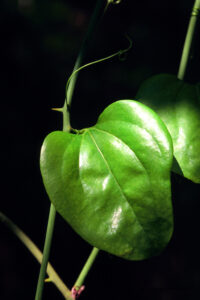
Greenbriar. This image is marked with a CC BY 3.0 license.
What Harm Do Invasive Plants Cause?
Every biological invasion begins with the movement of a species from one place to another. How do invasives species move? Well, as humans move around the world, plants and animals move with them. Small animals like insects and mollusks can stow away in ballast water or shipping crates. Plants can attach themselves to boats on the move, and many invasive plants were introduced as ornamentals that escaped the confines of homeowner’s gardens. Climate change is also contributing to the movement of invasive species as they shift their ranges to escape warming temperatures. Invasive plants are fast-growing due to their high seed production and aggressive root systems. They also have few natural predators in a new environment. Once these species reach unknown lands, their ability to grow quickly allows them to compete with native species for resources like water, food, space, and sunlight. Additionally, when invasives take over an environment, that environment loses biodiversity due to a reduction in plant species richness (the number of unique plant species). Invasive plants negatively impact both wildlife and humans. According to the U.S. Forest Service, they have contributed to the decline of 42% of vulnerable species in the United States (source here). They do this by competing with and eliminating plants that provide food and habitat for native wildlife. Regarding their impacts on humans, invasive species cost the global economy billions of dollars annually. They damage agricultural crops that people rely on for sustenance and spread harmful diseases that can infect human populations.
Common Invasive Plants on Cape Cod:
Here are five invasive plant species that you are likely to see on Cape Cod. Keep a look out for these while walking the trails at the Refuge’s different properties.
1. Multiflora Rose
Although multiflora rose produces pretty white and pink flowers in the spring, be aware of its thorns. Like many other invasives, multiflora rose is a concern because it displaces native species, and its sharp thorns make it a nuisance to hikers.
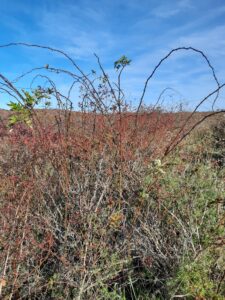
Image taken by Grace Vachon.
2. Honeysuckle:
A few different species of honeysuckle can be found on the Cape, including Japanese and Morrow’s honeysuckle. Japanese honeysuckle grows as a trailing vine, while Morrow’s honeysuckle grows as a shrub. Morrow’s honeysuckle grows in fields or forest understories, forming dense thickets that take away growing space from native plants. Both have white, tube-shaped flowers. The thick woody vines of Japanese honeysuckle can girdle trees.
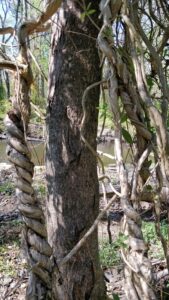
Japanese honeysuckle vines. These thick woody vines can suffocate and girdle trees. This image is marked with a CC BY 2.0 license.
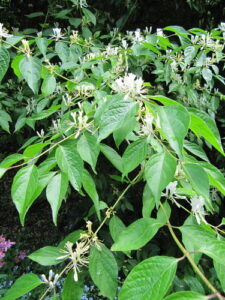
3. Bittersweet:
Bittersweet grows as a vine with woody stems and large, oval-shaped leaves. You may have seen its recognizable red and yellow berries, which provide food for birds and other wildlife. Its thick, woody stems can kill native plants by wrapping around them and smothering them. These stems form dense, tangled clumps that make it difficult to remove once it establishes itself in an area.
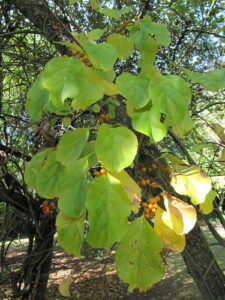
4. Japanese Knotweed:
Brought over from Asia as an ornamental in the 1800s, this shrub is easy to spot with its large oval leaves and clusters of small, white flowers. Its hollow stems look like bamboo and are often both green and purple in color. It tends to grow in wet areas like streambanks, drainage ditches, and wetlands.
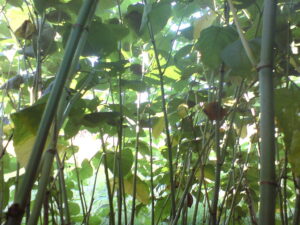
Japanese knotweed has bamboo-like stems. This image is marked with a CC BY 2.0 license.
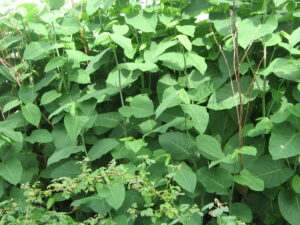
5. English Ivy:
English ivy is a creeping vine that you will often see growing up tree trunks, but it will also grow on the ground. It poses a severe threat to the trees it inhabits. Specifically, this thick vine can weigh trees down and block sunlight from reaching the tree canopy, causing the tree to die slowly over a long period of time.
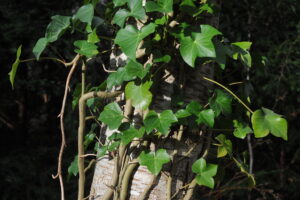
How Can We Manage Invasive Plants?
A major component of land stewardship is managing invasives. Organizations that manage and preserve land, such as land trusts, send a lot of time planning and executing invasive plant management strategies. A common plan of attack is physical removal either with hand tools like loppers and hand saws or power tools like brush cutters and weed whackers. Land managers might also use herbicides or other chemicals to kill unwanted plants. As a member of AmeriCorps Cape Cod, a lot of my service projects involve removal of invasive plants like thorny black locust trees, multiflora rose, bittersweet, and honeysuckle. It is also important to prevent invasive plants from becoming established in the first place. To prevent the introduction and spread of invasive plants, the Nature Conservancy recommends cleaning your boat and hiking boots after use to prevent invasive plant matter from being moved around. They also recommend not moving firewood that may harbor invasives, as well as being aware of the types of plants that you are planting in your garden. Are these plants native or invasive? If they are invasive, replace them with non-invasive alternatives. Historically, invasive plants have been revered for their beauty since many were brought over to be planted as ornamentals. However, it is important for gardeners to start recognizing and appreciating the beauty of native plants. Consider planting a native plant garden on your property or volunteering to help plant these gardens within your community.
Language Surrounding Invasive Plants:
Have you ever considered the language that we use to describe invasive plants? Think about terms like “exotic,” “alien,” and “invader.” What about violent language such as “going to war with,” “eliminating,” or “killing.” Although we are talking about plants here, what feelings do these terms evoke? They may evoke hostility or a fear of something foreign taking over an area, using up valuable resources, and disrupting the natural balance of life there. By using such language to talk about plants from other parts of the world, we are normalizing the fear and dislike of things that are foreign, which may translate to people, cultures, or traditions. The ways that we refer to invasives also mirrors the inflammatory language often used against human immigrants. Consider place-based names such as Japanese knotweed or Asiatic bittersweet. Place-based names may seem harmless since they simply refer to the place where the species originated. However, some people might associate the people of that country or culture with the destruction caused by the invasive species and blame them for the invasion. However, the people of that place are often not at fault. Rather, biological invasions have usually occurred after someone takes the species back with them after visiting a foreign land. These introductions can be purposeful in the case of ornamental plants or accidental in the case of stowaways on cargo ships. Therefore, it is important to think about the language that you use to talk about invasive species and the harmful messages it could convey.
Conclusion:
Invasive plants are quite common on Cape Cod and come in a variety of forms, including small shrubs and vines. Not only are they non-native, but they cause severe harm to landscapes, wildlife, and humans. However, all hope is not lost and the destruction that invasive plants cause can be addressed through a variety of means such as physical removal and replacement with native plants, herbicides, and the prevention of their spread. Just like climate change and other pressing environmental issues, it is going to require a lot of time, dedication, perseverance, and a diverse arsenal of strategies to tackle the problem of invasive species both on the Cape and around the world.
Additional Resources:
Visit these links to learn more about invasive plants and what you can do to prevent their spread.
Invasive Plant Atlas: https://www.invasiveplantatlas.org/
- This atlas contains basic information about a variety of invasive plants found across the United States.
Massachusetts Office of Coastal Zone Management: https://www.mass.gov/info-details/cz-tip-coastal-plant-identification-common-native-and-invasive-species-found-on-the-massachusetts-coast
Nature Conservancy: https://www.nature.org/en-us/what-we-do/our-priorities/protect-water-and-land/land-and-water-stories/invasive-plant-species-invasive-species-education-1/
- This article talks about how you can prevent the spread of invasive species.
Smithsonian Magazine: https://www.smithsonianmag.com/science-nature/why-scientists-are-starting-rethink-how-they-talk-about-alien-species-180967761/
- This article presents an interesting perspective on rethinking the language that we use to talk about invasive species.
